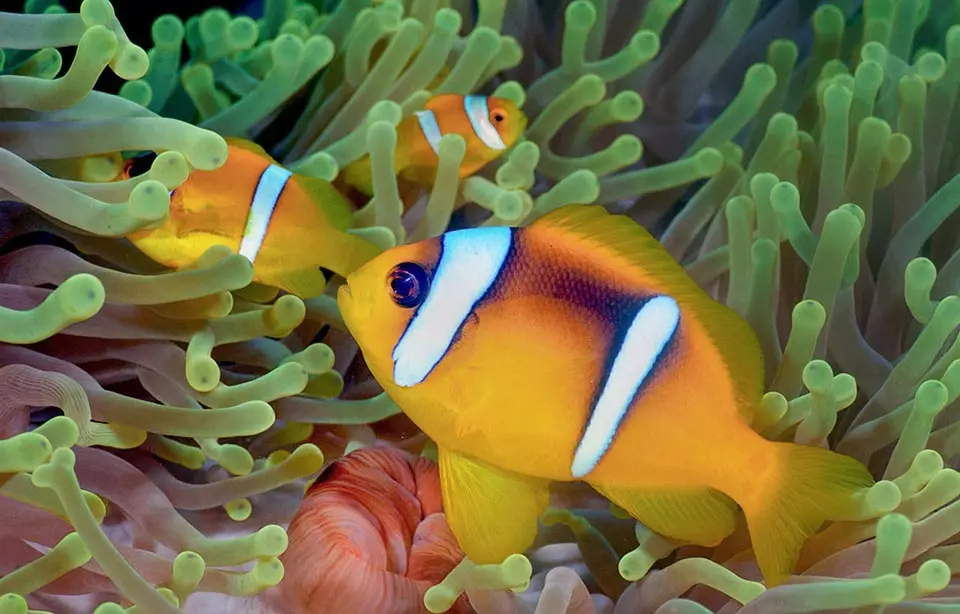Among the numerous species of clownfish, one of the least known and rare is Amphiprion albicinctus. This species lives in warm waters Andaman Sea, off the coast of Myanmar (Burma), and stands out dark orange body with wide white stripes. Due to its unique habitat and limited population, it is one of the most mysterious members of the genus. Amphiprion.
✔ Dark orange or reddish body with white stripes
✔ A broad white stripe running behind the eyes
✔ It lives in symbiosis with anemones in the waters of the Andaman Sea
✔ It is rarely found in aquariums due to its limited range.
This little-known species deserves special attention. Let's take a closer look at it!

Scientific classification
✔ The Kingdom: Animals (Animalia)
✔ Type: Chordal (Chordata)
✔ Class: Lucheperi pisces (Actinopterygii)
✔ Row: Perch-like (Perciformes)
✔ Family: Pomacentrovye (Pomacentridae)
✔ Gender: Amphiprion
✔ View: Amphiprion albicinctus (Allen, 1972)
📌 Interesting!
Title albicinctus it comes from Latin and means "belobosny ”, which indicates the characteristic white stripes on the body of this fish.
Appearance
🔹 Body shape:
✔ Oval, flattened on the sides
✔ Compact and hardy, which helps you maneuver quickly among the anemones
🔹 Color scheme:
✔ Main color – dark orange or reddish brown
✔ Two wide white stripespassing through the head and middle of the body
✔ Caudal fin light orange or whitish
🔹 Sizes:
✔ Average length: 10-12 cm
✔ Maximum length: up to 14 cm
📌 Interesting!
Coloration can vary from bright orange to dark brown depending on age and habitat.
Range and habitat
🌍 Where does Amphiprion albicinctus live?
✅ Andaman Sea
Воды Waters off the coast of Myanmar (Burma)
✅ Northern Indian Ocean
🔹 Living environment:
✔ Prefers coral reefs and lagoons with rich anemone colonies
✔ Occurs at depths of 2-20 meters
✔ Often inhabits among soft corals and sponges
📌 Interesting!
Due to its limited range, this species is not often found even in nature, which makes it poorly studied.

Symbiosis with sea anemones
🔹 How does symbiosis work?
✔ Clown uses anemone as a shelter from predators
In return, it cleanses the anemone and protects it from predatory fish
🔹 What kind of anemones does it co-exist with?
✔ Heteractis magnifica (majestic anemone)
✔ Stichodactyla gigantea (giant anemone)
📌 Interesting!
Unlike many other clownfish, this species mainly coexists with anemones that live in soft corals.
Lifestyle and behavior
🔹 Social structure:
✔ Lives in groups: dominant female, male and several young individuals
✔ The largest individual – female, the rest are males
🔹 Defensive behavior:
✔ Quite aggressive, guards its territory
✔ Fends off even bigger rivals
🔹 Life span:
✔ In the wild: 6-10 years old
✔ In captivity: up to 12 years old
📌 Interesting!
If the dominant female dies, the largest male changes sex and takes its place.
Nutrition and environmental role
🥗 What does amphiprion albicinctus eat?
✅ Small zooplankton
✅ Crustaceans
, Seaweed
🔹 Environmental role:
✔ Cleanses the anemone from food residues
✔ Controls the abundance of small marine organisms
📌 Interesting!
This species is less likely to hunt zooplankton in open water and relies more on small organisms that live near reefs.
Reproduction and development
🔹 Method of reproduction:
✔ Female lays eggs 300-800 eggs
✔ The male guards the clutch, ventilates the eggs
🔹 Development:
✔ Larvae swim in the water column up to 2 weeks
✔ Juveniles settle among anemones after metamorphosis
📌 Interesting!
Larvae of this species are very sensitive to changes in water temperature and pollution.

Amphiprion albicinctus and man
🔹 Popularity in aquariums:
Редко Rarely found in marine aquariums
Вынос Hardy, but sensitive to environmental changes
🔹 Industrial value:
✅ Bred in nurseries for sale
📌 Interesting!
Due to its rarity, this species is rarely seen in the marine aquarium fish market.
Species conservation and environmental threats
🔹 Population status:
✅ The species is not threatened, but its population is limited
🔹 Main threats:
Ruinuvannya coral reef destruction
Zabrudnennya ocean pollution
🔹 Security measures:
✔ Marine reserves
✔ Controlled catch
📌 Interesting!
The population of this species largely depends on the state of coral reefs in the region.
Conclusion
🐠 Amphiprion albicinctus is a unique reef dweller that impresses with its rarity and beautiful color.
💡 Would you like to see this mysterious clown in the wild? 🌊✨